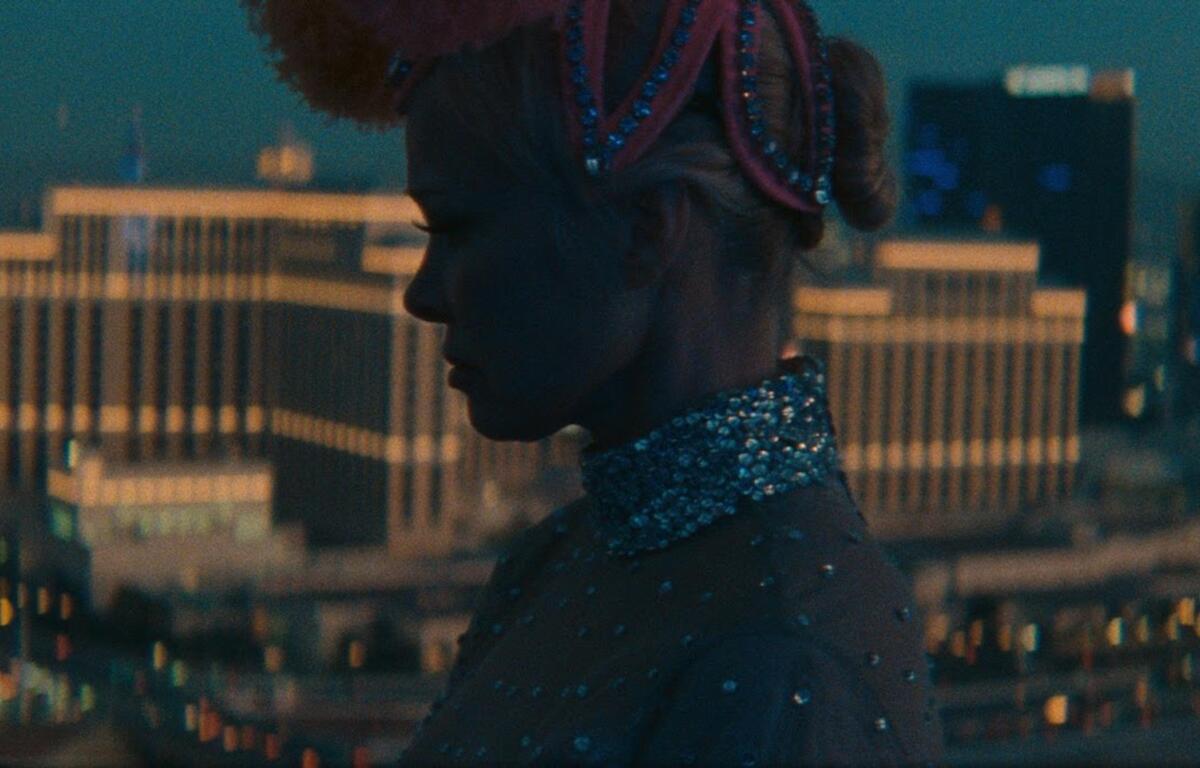“THE LAST SHOWGIRL” (2024, 89 min., directed by Gia Coppola)
There is a tender softness to every leg kick and costume change in “The Last Showgirl.”
Director Gia Coppola and cinematographer Autumn Durald shoot their actors under an oneiric, out-of-focus lens, setting the neon lights of the Las Vegas strip as anchors in the film’s pastel haze. It’s only truly in close-up that the characters of “Last Showgirl” are illuminated – for these women, the world around them feels less real than their spotlight.
Read our review of “Nosferatu” here.
Pamela Anderson stars as Shelly, a woman who has spent decades performing in Le Razzle Dazzle, a Vegas burlesque show. Shelly is introduced as blonde, breathy and vain. She is at once a matriarch of her crew and eternally the ingénue; even as the world moves past her and Le Razzle Dazzle announces its end, Shelly refuses to cede her scrap of the spotlight.

Anderson is tremendous in the part.
Read our review of “Babygirl” here.
The stereotype that defined the “Baywatch” star’s career – blonde bauble Barbie – is used in “Last Showgirl” as a cipher into Shelly. Anderson grants her character an excruciating, devastating naiveté that feels like a glimpse into the actor herself. Shelly can’t accept her show is over, and in embodying her, Anderson’s show goes on.
The film is soft in other ways, too. Its runtime is a soft pitch of 89 minutes. Its side-plots feel a little under-baked. Jamie Lee Curtis, Kiernan Shipka and Disney Channel alum Brenda Song are allowed too little material for their great talents. Billie Lourd is given too much. A subplot with Dave Bautista feels limp.
Read our review of “Wicked” here.
Yet Anderson deftly accomplishes the hardest part of her career. At an age when many women are forced out of the limelight, “Last Showgirl” puts Anderson at center stage.
Rating: 3/5
“BETTER MAN” (2024, 135 min., directed by Michael Gracey)
Full disclosure, I didn’t know who Robbie Williams was before seeing his biopic. The British pop star is, the movie tells me, a big deal around the world. For whatever reason, Williams never broke through in the United States. This film doesn’t make a great first impression.

“Better Man” is another rote entry in the musician biopic genre, following “A Complete Unknown” just weeks ago. The film is indistinguishable from many films of its ilk in plot: a young dreamer who feels like an outcast grows up to be a world famous musician and descends into the vices of celebrity before a near-death denouement that introduces a climactic, sanitized comeback. Roll credits.
Read our review of “A Complete Unknown” here.
However, there’s one innovation in “Better Man” that sets it apart from its brethren.
Williams is played by a CGI monkey.
That’s right. “Better Man” is a film about a monkey who sings, swears, swigs and jigs. The admittedly audacious choice is meant to emphasize how Williams feels like a dancing monkey as a foul-mouthed famous singer, “unevolved” and inhuman. The digital creation in the real, hard world of sex, drugs and British pop music should call attention to how outside the norm Williams feels.
Read our review of “Queer” here.
Instead, it has the inverse effect. The entirety of “Better Man” feels uncanny and strange. Scenes that should be deeply moving or dark and harrowing are hollow and absurd. Nothing that happens to Monkey Williams feels tangible, even when he slouches through a door with a heroin needle in his arm or drives a car through a crowd of people.
Without their humanity, the film’s tragedies amount to tepidity.
A recurring anthem throughout the film is Frank Sinatra’s “My Way,” which Monkey Williams performs with microphone-flipping swagger in an obvious middle-finger – a frequent gesture in “Better Man” fully rendered in fur-pawed CGI – to Williams’ critics.
Consider me one of them.
Rating: 2/5


